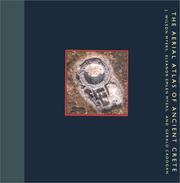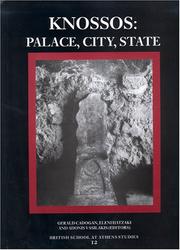| Listing 1 - 10 of 10 |
Sort by
|

ISBN: 9004073094 9789004073098 Year: 1986 Volume: 6 Publisher: Leiden: Brill,
Abstract | Keywords | Export | Availability | Bookmark
 Loading...
Loading...Choose an application
- Reference Manager
- EndNote
- RefWorks (Direct export to RefWorks)
Civilization, Aegean --- Congresses --- Caskey, John L --- -Aegean civilization --- Caskey, John L. --- -Congresses --- Aegean civilization --- Congresses. --- Bronze (Age du). Egée (Mer) (Pays de la). --- Bronstijd. Ege sche Zeelanden. --- Bronstijd. Ege©s¯sche Zeelanden. --- Civilization, Aegean - Congresses --- Caskey, John L - (John Langdon) - Congresses --- Caskey, John L - (John Langdon)
Book
ISBN: 9004674896 Year: 1986 Publisher: Leiden : Brill,
Abstract | Keywords | Export | Availability | Bookmark
 Loading...
Loading...Choose an application
- Reference Manager
- EndNote
- RefWorks (Direct export to RefWorks)
Book
ISBN: 0214200795 Year: 1976 Publisher: London : Barrie & Jenkins,
Abstract | Keywords | Export | Availability | Bookmark
 Loading...
Loading...Choose an application
- Reference Manager
- EndNote
- RefWorks (Direct export to RefWorks)
Book
ISBN: 9780904887648 0904887642 Year: 2011 Volume: 46 Publisher: London: British School of Athens,
Abstract | Keywords | Export | Availability | Bookmark
 Loading...
Loading...Choose an application
- Reference Manager
- EndNote
- RefWorks (Direct export to RefWorks)
"From 1957 to 1961 the British School at Athens undertook an extensive programme of stratigraphical excavations at Knossos under Sinclair Hood, then Director of the School. This report publishes in detail the results of investigations into Early Minoan levels, which shed much new light on the era before the 'Old Palace' was established. The three excavations comprised: an Early Minoan I deep well, the oldest at Knossos; trials on the north side of the Royal Road, with Early Minoan II-III house remains, and similar trials in the Early Houses below the South Front of the Palace, which included investigation of the South Front House of Early Minoan III. The volume provides invaluable data on the types and phased development of pottery in this major settlement site of the third millennium BC, a period when much of our Cretan evidence derives from tombs. It also helps to chronicle the expansion of Knossos during the Early Bronze Age, and offers new insights into the material culture of Prepalatial society, including possible feasting in Early Minoan I, new evidence for olives and wine, and well-dated Early Minoan III seal impressions of the Parading Lions group. A valuable addition is a chapter devoted to other Early Minoan pottery from Knossos, held in museums in Europe and the USA. Copiously illustrated with line drawings and photographs, the volume will serve as a major resource for all interested in early cultural developments in the Aegean and Eastern Mediterranean"--Publisher's description, p. [4] of dust jacket.
Excavations (Archaeology) --- Minoans --- Knossos (Extinct city) --- Crete (Greece) --- Antiquities --- Human settlements --- Archaeology --- Civilization, Minoan --- Civilization, Aegean --- Cretans --- Cnossos (Extinct city) --- Cnossus (Extinct city) --- Gnossus (Extinct city) --- Knosós (Extinct city) --- Knossos (Ancient city) --- Greece --- Antiquities. --- Archaeological digs --- Archaeological excavations --- Digs (Archaeology) --- Excavation sites (Archaeology) --- Ruins --- Sites, Excavation (Archaeology) --- Excavations (Archaeology) - Greece - Crete --- Crete (Greece) - Antiquities
Book
ISBN: 0416731600 Year: 1980 Publisher: London Methuen
Abstract | Keywords | Export | Availability | Bookmark
 Loading...
Loading...Choose an application
- Reference Manager
- EndNote
- RefWorks (Direct export to RefWorks)
Crete --- -Excavations (Archaeology) --- -Minoans --- Palaces --- -Buildings --- Civilization, Minoan --- Civilization, Aegean --- Cretans --- Archaeological digs --- Archaeological excavations --- Digs (Archaeology) --- Excavation sites (Archaeology) --- Ruins --- Sites, Excavation (Archaeology) --- Archaeology --- Antiquities --- Greece --- Antiquities. --- -Civilization, Minoan --- Excavations (Archaeology) --- Minoans --- Buildings --- Crete (Greece) --- Minoans.
Book
ISBN: 9789606878916 9606878910 Year: 2015 Publisher: Athens Kapon Editions
Abstract | Keywords | Export | Availability | Bookmark
 Loading...
Loading...Choose an application
- Reference Manager
- EndNote
- RefWorks (Direct export to RefWorks)
Gerald Cadogan's contributions to the archaeology of the East Mediterranean are directly related to the two Great Islands, Crete and Cyprus where he has directed excavations at Myrtos-Pyrgos and Maroni-Vournes respectively. This volume, comprising mostly Cretan and Cypriot studies, is offered by an array of scholars who have been taught or examined by Cadogan or who have collaborated with him in the field or excavation workrooms over the last fifty years. More than thirty short papers reflect Cadogan's wide range of interests from interpreting excavation data--architecture, stratigraphy, pottery and small finds--to matters of prehistoric chronology, ethnography and gender, technology, environment and osteology, mythology and iconography, religion and death. The collection is a fascinating testament to the continuing achievements of one of the finest archaeologists of the region.
Minoans. --- Prehistoric peoples --- Bronze age --- Excavations (Archaeology) --- Civilization --- Cavemen (Prehistoric peoples) --- Early man --- Man, Prehistoric --- Prehistoric archaeology --- Prehistoric human beings --- Prehistoric humans --- Prehistory --- Human beings --- Antiquities, Prehistoric --- Civilization, Minoan --- Civilization, Aegean --- Cretans --- Crete (Greece) --- Cyprus --- Greece --- History --- History. --- Antiquities. --- Minoans --- Archaeological digs --- Archaeological excavations --- Digs (Archaeology) --- Excavation sites (Archaeology) --- Ruins --- Sites, Excavation (Archaeology) --- Archaeology --- Primitive societies

ISBN: 0520073827 Year: 1992 Publisher: Berkeley : University of California Press,
Abstract | Keywords | Export | Availability | Bookmark
 Loading...
Loading...Choose an application
- Reference Manager
- EndNote
- RefWorks (Direct export to RefWorks)
Book
ISBN: 9781931534611 1931534616 9781623031176 Year: 2011 Publisher: Philadelphia INSTAP Academic Press
Abstract | Keywords | Export | Availability | Bookmark
 Loading...
Loading...Choose an application
- Reference Manager
- EndNote
- RefWorks (Direct export to RefWorks)
Since the inception of Minoan archaeology, studies pertaining to tombs and tomb deposits have played seminal roles in our understanding of Minoan culture and the reconstruction of Bronze Age society. For several geographical areas and chronological periods of Cretan history, tombs are the most abundant source of data. Each author in this volume takes a clear and distinct approach to the data, including some that emphasise political geography on multi-regional and multi-scalar levels, some that examine the commemoration of the dead and of the community for legitimising purposes but also for maintaining and/or creating elite positions in social systems and others that underline the overlap between mortuary rituals and religion. The aim of this volume is not to present all tombs in all periods on Crete comprehensively but the breadth of these papers is intended to generate a discourse not just among archaeologists working in different areas and time periods on Crete but also among archaeologists in Greece and a broader anthropological audience.
Tombs --- Burial --- Antiquities, Prehistoric --- Excavations (Archaeology) --- Minoans --- Bronze age --- Crete (Greece) --- Antiquities --- Tombs - Greece - Crete --- Burial - Greece - Crete --- Antiquities, Prehistoric - Greece - Crete --- Excavations (Archaeology) - Greece - Crete --- Bronze age - Greece - Crete --- Crete (Greece) - Antiquities --- Funeral rites and ceremonies --- Antiquities.

ISBN: 0904887456 9780904887457 Year: 2004 Volume: 12 Publisher: Athens: British school at Athens,
Abstract | Keywords | Export | Availability | Bookmark
 Loading...
Loading...Choose an application
- Reference Manager
- EndNote
- RefWorks (Direct export to RefWorks)
Minoans --- Excavations (Archaeology) --- Minoens --- Fouilles (Archéologie) --- Congresses. --- Congrès --- Knossos (Extinct city) --- Crete (Greece) --- Cnossos (Ville ancienne) --- Crète (Grèce) --- Congresses --- Antiquities --- Antiquités --- Antiquities. --- Fouilles (Archéologie) --- Congrès --- Crète (Grèce) --- Antiquités --- Excavations (Archaeology) - Cyprus - Congresses. --- Knossos (Extinct city) - Antiquities.
Book
ISBN: 9780904887662 0904887669 Year: 2012 Publisher: Athens: British school at Athens,
Abstract | Keywords | Export | Availability | Bookmark
 Loading...
Loading...Choose an application
- Reference Manager
- EndNote
- RefWorks (Direct export to RefWorks)
How do the cultures of Crete and Cyprus, the two great islands of the eastern Mediterranean, compare in their history and development from the 3rd millennium to the 1st millennium BC? What was similar and what was different in their social and political, economic and technological, and religious and mortuary practices and behaviours, and in the natural settings and choices of places for settlements? Why, and how, did convergences and divergences come about? Why for instance did monumental buildings appear in Cyprus several centuries after they had emerged in Crete? And what was the impact on Cypriot society of the island's rich copper resources, while Crete as a rule had to import the metal? How and why did Cyprus manage an apparently much more peaceful transition from the Bronze Age to the Iron Age than Crete? These are among the important questions that a leading group of experts on the two islands addressed at Parallel Lives, a pioneering conference in Nicosia organised by the British School at Athens, the University of Crete and the University of Cyprus, to compare and discuss the islands' cultural trajectories diachronically from c. 3000 BC through their Bronze Ages and down to their loss of independence in 300 BC for Cyprus and 67 BC for Crete. Papers given then are now presented in fully revised form as chapters in this book, which is the first to bring together the study of Crete and Cyprus in this way, while starting with their insular geo-cultural identities. It will be a valuable resource for students of both islands, for all who are interested in ancient material cultures and mentalities in the Mediterranean, as well as those engaged in island studies across the world.
Crete (Greece) --- Cyprus
| Listing 1 - 10 of 10 |
Sort by
|

 Search
Search Feedback
Feedback About UniCat
About UniCat  Help
Help News
News